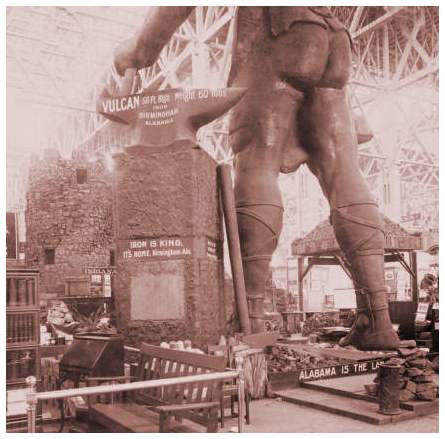Instead of constructing a state pavilion, Alabama spent all its appropriations on a 60-ton statue of the Roman go of the forge- Vulcan. The model of the colossal statue was first built in clay at Passaic, N.J., where Giseppe Moretti carried on the work under adverse circumstances and through the zero weather of the winter of 1903-4. It was then cast in plaster of Paris in sections, which were braced and stayed with scantling on the inside of
the shell, to be used as patterns in the foundry. The entire model was shipped to Birmingham, Ala., on seven flat cars, its bulk rendering it impossible to put it in box cars. As soon as it reached Birmingham, the work of casting the figure in iron was begun in the foundry of the Birmingham Steel and Iron Company.
Giseppe Moretti went to Birmingham to keep the patterns in condition during the process of casting, as the extreme cold had frozen the plaster casts before they were dry, rendering them brittle. Many broke, including the head pieces, which had to be remodeled.
Its height is 56 feet, and its weight- 120,000 pounds. The head was cast in one piece and weighed close to 8 tons. There were 20 casts in all, including the anvil and anvil block. The statue, which was intended to show forth the colossal iron deposits of Alabama, representing primitive man at the time he discovered the method of hardening iron into steel. Vulcan held aloft in his right hand the finished spearhead as a result of his knowledge and handicraft. It is the largest cast statue in the world, and it could not be duplicated for less than 40,000 dollars.
Iron manufacturers from all parts of the world have said that the Vulcan statue was the most remarkable piece of iron casting they had ever seen.
The statue was successfully completed and set up in the Exposition within three weeks after the day of the Fair's opening.
The statue of Vulcan stood in the center of one side of the space facing the center of the Mines Palace. It was placed on a platform built upon nine heavy piles, which were driven into bedrock to support the statues great weight. The figure was perfectly poised when set up, but as an additional safeguard anchor bars
were run down through the legs and through a heavy timber, which was bolted to the piles. Around the statue, there were exhibits of Alabama's raw mineral products.
After the Fair, the statue was dismantled shipped back to Birmingham, where it was left to rot because of unpaid bills.
Re-erected, the Vulcan statue was used as advertising everything from Coca-Cola to pickles. In 1930 the statue was taken down and re-painted.
In 1936, a new park in Birmingham became the new home for Vulcan. It was hoisted onto a new 126 foot pedestal. A new spear was placed in its hands and it was repainted with an aluminum finish.
In 1971, the area around the statue was renovated, and then in 1999 the statue was removed to be repaired. It was refurbished and set atop a new Vulcan Center and pedestal restored to its 1938 appearance in 2004.


